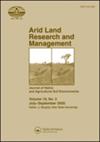H2O2灌种提高了盐胁迫下向日葵植株的光合效率和生物量
IF 1.6
4区 农林科学
Q3 ENVIRONMENTAL SCIENCES
引用次数: 6
摘要
盐度通常影响全球的光合作用和作物生产。然而,一些研究表明,过氧化氢种子激发可以提高植物对盐胁迫的耐受性。在此背景下,本研究旨在验证H2O2种子激发可以提高盐胁迫下向日葵植株光合效率的假设。试验采用完全随机设计,共设4个重复。试验了六种处理:对照(去离子水);盐控制(100 mM NaCl);0.1 mM H2O2 (36 h) + 100 mM NaCl;1 mM H2O2 (24 h) + 100 mM NaCl;10mm H2O2 (12h) + 100mm NaCl;100mm H2O2 (12h) + 100mm NaCl。与对照处理相比,胁迫植株叶片、茎和根的干质量分别降低了73%、76%和71%。然而,在种子被H2O2激发的植物中,这种效果不那么明显。5周后,H2O2种子注入使CO2同化率提高了26%,瞬时羧化效率提高了38%,光系统II的潜在量子产率和光化学猝灭量子产率提高了22%,电子速率传递提高了43%,叶绿素b含量提高了71%。此外,与盐控处理相比,其非光化学淬火参数降低了22%。本文章由计算机程序翻译,如有差异,请以英文原文为准。
Seed priming with H2O2 improves photosynthetic efficiency and biomass production in sunflower plants under salt stress
Abstract Salinity commonly affects photosynthesis and crop production worldwide. However, some studies have shown that hydrogen peroxide seed priming can increase the tolerance of plants to salt stress. In this context, this study aimed to test the hypothesis that the H2O2 seed priming can improve photosynthetic efficiency in sunflower plants under salt stress. The experiment was conducted in a completely randomized design, with four replicates. Six treatments were tested: control (deionized water); salt control (100 mM NaCl); 0.1 mM H2O2 (36 h) + 100 mM NaCl; 1 mM H2O2 (24 h) + 100 mM NaCl; 10 mM H2O2 (12 h) + 100 mM NaCl; and 100 mM H2O2 (12 h) + 100 mM NaCl. Compared to the control treatment, leaf, stem and root dry mass of stressed plants showed 73, 76, and 71% reduction, respectively. However, this effect was less pronounced in plants whose seeds were primed with H2O2. After five weeks, H2O2 seed priming increased the CO2 assimilation rate by 26%, instantaneous carboxylation efficiency by 38%, potential quantum yield and quantum yield of photochemical quenching of photosystems II by 22%, electron rate transport by 43%, and the chlorophyll b content by 71%. In addition, it reduced the non-photochemical quenching parameters by 22% compared to plants under salt control treatment.
求助全文
通过发布文献求助,成功后即可免费获取论文全文。
去求助
来源期刊

Arid Land Research and Management
环境科学-环境科学
CiteScore
3.80
自引率
7.10%
发文量
23
审稿时长
9 months
期刊介绍:
Arid Land Research and Management, a cooperating journal of the International Union of Soil Sciences , is a common outlet and a valuable source of information for fundamental and applied research on soils affected by aridity. This journal covers land ecology, including flora and fauna, as well as soil chemistry, biology, physics, and other edaphic aspects. The journal emphasizes recovery of degraded lands and practical, appropriate uses of soils. Reports of biotechnological applications to land use and recovery are included. Full papers and short notes, as well as review articles and book and meeting reviews are published.
 求助内容:
求助内容: 应助结果提醒方式:
应助结果提醒方式:


